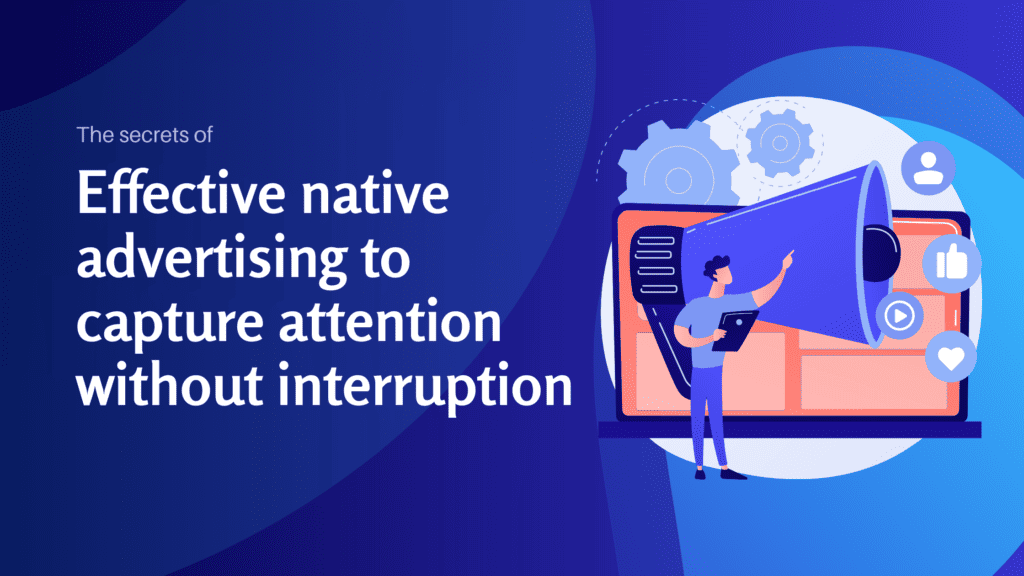Introduction
In a world where consumers are constantly bombarded by advertising, it has become essential to find innovative ways of capturing their attention without interrupting them. That’s where native advertising comes in. Native advertising offers a subtle, non-intrusive approach to targeting consumers at the right time and in the right way.
The key to effective native advertising lies in its ability to integrate seamlessly with editorial content, without being perceived as a distracting interruption. By using attractive, relevant formats, native advertising can engage readers’ interest while encouraging them to discover more about the brand or product. In this article, we’ll explore the secrets of effective native advertising to capture attention without interruption.
Understanding native advertising
Native advertising is a form of advertising that integrates seamlessly with editorial content, making it less intrusive for consumers. Unlike traditional advertising, which is easily identifiable and often perceived as an interruption, native advertising offers a more fluid and natural user experience. It adapts to the context of the platform on which it is broadcast, making it more attractive to readers.
Native advertising can take many forms, such as sponsored articles, embedded videos, content recommendations or online ads that resemble articles or posts on social networks. The main aim of native advertising is to attract consumers’ attention without disrupting their reading or browsing experience. It also offers brands a unique opportunity to connect meaningfully with their target audience.
Native and traditional advertising
Native and traditional advertising are two different approaches to reaching consumers, each with its own advantages and disadvantages. While traditional advertising is often perceived as an annoying interruption, native advertising offers a smoother, less intrusive user experience.
Traditional advertising is easily identifiable and takes the form of banner ads, TV spots or print ads. It’s generally more direct, highlighting the features and benefits of a product or service. However, it can be perceived as intrusive and aggressive, which can lead to consumer resistance.
Native advertising, on the other hand, integrates seamlessly with editorial content, making it less intrusive and more appealing to consumers. It offers a more fluid and natural user experience, which can lead to higher consumer engagement. However, native advertising can be more difficult to set up and optimize, as it requires a good understanding of the editorial content and the platform on which it is delivered.
It’s important to understand the differences between native and traditional advertising so you can choose the best approach to reach your target audience. In some cases, a combination of the two approaches may be the best way to achieve the desired results.
Statistics on native advertising
Native advertising statistics offer crucial insight into the trends and effectiveness of this form of integrated advertising. Native advertising is distinguished by its harmonious integration with editorial content, offering a more natural user experience.
Some key statistics to give you an idea of its impact and evolution
1. Continuous growth
Native advertising has grown steadily over the years. According to several industry reports, global spending on native advertising has been rising steadily, demonstrating advertisers’ growing preference for this approach.
2. Greater commitment
Consumers react positively to native advertising because of its non-intrusive nature. Studies show that engagement rates are often higher with native advertising than with other forms of online advertising, because it integrates organically with the context of the content.
3. Increased trust
Consumers tend to trust native advertising more than traditional advertising formats. This trust stems from the less intrusive aspect of native advertising and its ability to provide useful information rather than simply sell a product.
4. Diversified formats
Native advertising adapts to a variety of formats, including sponsored articles, embedded videos, content recommendations and widgets. This versatility allows advertisers to choose the format that best suits their message and target audience.
5. Mobile-first
With the rapid growth in the use of mobile devices, native advertising is increasingly aligned with formats adapted to smartphones and tablets. Native mobile ads are gaining in popularity due to their adaptability to different screens and their ability to deliver an optimal user experience.
6. Attractive ROI
Advertisers often see an attractive return on investment (ROI) with native advertising due to its effectiveness in generating meaningful interactions with consumers. Natural association with editorial content can lead to higher conversions.
7. Popularity on social networks
Social media platforms have widely adopted native advertising. Platforms such as Facebook, Instagram and Twitter have integrated native ad formats into their feeds, offering advertisers increased visibility with their target audiences.
Key elements of effective native advertising
Effective native advertising relies on a number of key elements aimed at creating a seamless, engaging experience for users while meeting advertisers’ marketing objectives.
Some key elements to consider when creating your native ads
To create effective native advertising, it’s essential to understand the key elements that make it attractive and engaging for consumers. Here are some key elements to consider when creating your native ads:

1. Relevance
Make sure your native advertising is relevant to your target audience and editorial content. It must offer added value and be in tune with your audience’s interests and needs. The more relevant your advertising is, the more interest it will arouse among consumers.
2. Integration
Native advertising must integrate seamlessly with editorial content, without being perceived as an interruption. It should be designed in the same style and tone as the surrounding content, making it more attractive and engaging for readers.
3. Creativity
Native advertising has to be creative and captivating to grab consumers’ attention. Use eye-catching visuals, catchy headlines and compelling calls to action to encourage readers to find out more about your brand or product.
4. Legibility
Make sure your native ad is easy to read and understand. Use legible fonts, short paragraphs and simple sentences to make reading easier. Avoid texts that are too long or too complex, which could discourage consumers.
5. The call to action
Include a clear and compelling call to action in your native ad. Encourage consumers to act by giving them a reason to click on your ad or visit your website. Use action verbs and powerful words to encourage commitment.
Choosing the right platform for native advertising
Choosing the right platform for native advertising is a crucial decision in a company’s marketing strategy. It goes beyond simply selecting a distribution channel, and requires a thorough understanding of the target audience, specific marketing objectives, and the type of content to be promoted. Indeed, each platform offers unique features, varied formats and specific reach, making it a key differentiator in the complex landscape of online advertising.
Some factors to consider when choosing your native advertising platform
1. Audience
Make sure the platform you choose has an audience that matches your target audience. Check the platform’s demographics and usage statistics to make sure it’s reaching the people you want to target.
2. Background
The platform must offer the right context for your native advertising. It must be able to deliver your ad seamlessly and match it to the surrounding editorial content. Check the quality and relevance of the content on the platform before making your decision.
3. Visibility
Make sure the platform offers maximum visibility for your native ads. Check the available locations and the frequency of your ads. You want to make sure that your ads reach a large number of people and are well positioned to attract attention.
4. Formats
The platform must support the advertising formats you want to use. Make sure it offers sufficient flexibility to create attractive and relevant native ads. You want to be able to use different formats, such as sponsored articles, embedded videos or content recommendations.
Some examples of popular platforms for native advertising
1. Facebook
With its vast user base, Facebook offers significant opportunities for native advertising. Sponsored ads in the News Feed, Instant Articles and video ads are examples of native formats on this platform.
2. LinkedIn
LinkedIn offers sponsored ads and sponsored articles that blend naturally into the flow of professional activity. It’s a solid option for native advertising in the B2B sector.
3. Taboola
Taboola is a content discovery platform that enables advertisers to promote their content natively on a network of partner sites, reaching a wide audience.
4. Outbrain
Outbrain is a content recommendation platform that enables advertisers to deliver their content natively to third-party sites.
5. Pinterest
Pinterest offers sponsored ads that integrate naturally into users’ boards and feeds, focusing on visual inspiration.
Creating compelling native advertising content
Creating compelling native advertising content requires a strategic approach focused on engagement, added value and natural integration into the editorial context.
Tips for creating effective native advertising content
1. Know your target audience
Before you start, gain a thorough understanding of your target audience’s demographics, interests and behaviors. This will help you tailor the tone, style and content of your ad to maximize its appeal.
2. Harmonious integration
Make sure your ad fits seamlessly into the surrounding content. Design, typography and tone must match the platform’s editorial style, offering a consistent user experience.
3. Providing added value
Rather than focusing solely on promoting your product or service, create content that offers real added value to users. Inform, entertain or educate your audience to generate genuine interest.
4. Catchy titles
Titles play a crucial role in attracting users. Create catchy headlines that arouse curiosity and encourage people to find out more. Be creative, but make sure the title stays in line with the tone of the editorial content.
5. Captivating visuals
Use high-quality, relevant visuals. Whether images, infographics or videos, visual elements must be aesthetically appealing and complement the advertising message.
6. Engaging narration
Tell a compelling story that grabs the user’s attention right from the start. A well-constructed narrative can evoke emotions and create a deeper connection with the audience.
Strategies for maximizing the impact of native advertising
Maximizing the impact of native advertising requires a skilful combination of strategies to capture the attention of the target audience, foster engagement and achieve marketing objectives.
A few tips to help you increase the reach of your native ads
1. Search engine optimization (SEO)
Use relevant keywords in the title and description of your native ad. This will help search engines index your content and make it more easily accessible to users.
2. Share on social networks
Share your native ad on social networks and encourage users to share it. This will increase the reach of your content and reach a wider audience.
3. Involvement of influencers
Involve relevant influencers in promoting your native advertising. Influencers have a loyal and trusted audience, which can increase the credibility and impact of your native advertising.
4. Creating internal links
Create internal links to your native ad from other articles or pages on your website. This will help increase the visibility of your content and improve its search engine ranking.
Measuring the success of native advertising campaigns
Measuring the success of native advertising campaigns is a crucial element of any modern marketing strategy. The importance of this evaluation lies in the ability to understand not only the quantitative impact of your campaigns, but also the qualitative way in which your audience reacts to your advertising content.
Some key indicators to consider when measuring the success of your native advertising campaigns
Measuring the success of your native advertising campaigns is essential to assess their impact and make any necessary adjustments. Here are some key indicators to consider when measuring the success of your native advertising campaigns:
1. Duration of commitment
Measures the average time users spend interacting with your ad. Use analytics tools to track the time spent per user on the ad page. Longer engagement times suggest more captivating content.
2. Click-through rate
Measure the number of people who clicked on your native ad to find out more about your brand or product. A high click-through rate indicates that your ad has aroused interest and prompted users to find out more.
3. Conversion rates
Measure the number of people who took a desired action after seeing your native ad, such as making a purchase or signing up for a newsletter. A high conversion rate indicates that your ad has succeeded in convincing users to take action.
4. Time spent on page
Measure how long users spend on the page where your ad is displayed. A high time spent indicates that your ad has succeeded in capturing users’ attention and engaging them.
Conclusion
Native advertising offers a subtle, non-intrusive approach to capturing consumers’ attention without interrupting them. By choosing the right distribution channels, creating engaging content and optimizing the visibility of your native ads, you can maximize their impact and achieve positive results.





